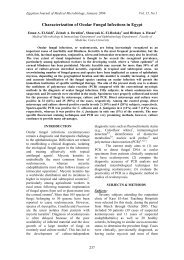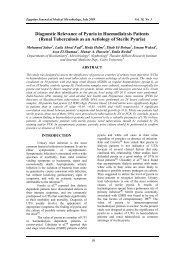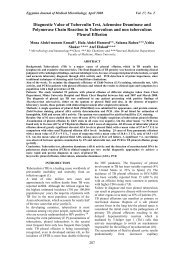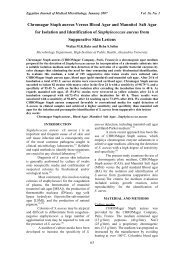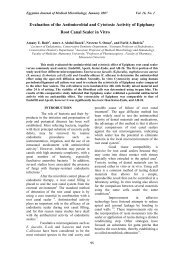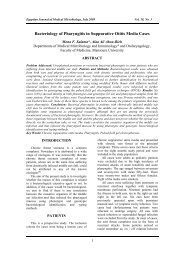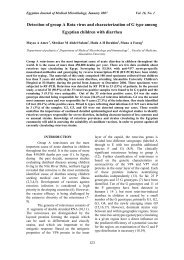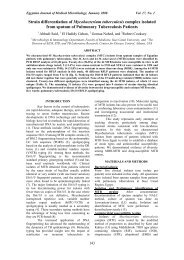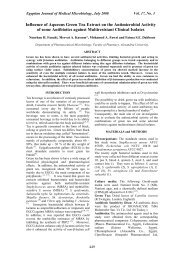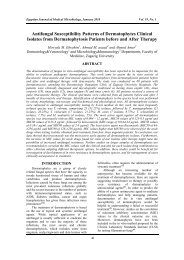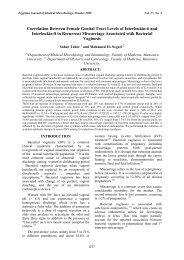Characteristics and Outcome of Patients with Influenza A (H1N1 ...
Characteristics and Outcome of Patients with Influenza A (H1N1 ...
Characteristics and Outcome of Patients with Influenza A (H1N1 ...
You also want an ePaper? Increase the reach of your titles
YUMPU automatically turns print PDFs into web optimized ePapers that Google loves.
Egyptian Journal <strong>of</strong> Medical Microbiology, January 2010 Vol. 19, No. 1shaped curve previously seen only during the1918 <strong>H1N1</strong> Spanish p<strong>and</strong>emic 20 . Few patientsolder than 60 years were admitted to the ICU. Apotential biological basis for this observation isthat patients in this age group have a crossreactiveantibody to 2009 influenza A (<strong>H1N1</strong>) atmuch higher rates than younger patients 21 .(<strong>H1N1</strong>) 2009 influenza A recorded casefatalityrate <strong>of</strong> approximately 1% yet this maywell be an overestimate, because testing is nolonger being reported in many regions <strong>and</strong> evenmany cases expected as mild flu <strong>with</strong>outtesting 22 . The case-fatality rate in previousinfluenza p<strong>and</strong>emics has varied widely, <strong>and</strong> allsuch reports may be inaccurate owing todifficulty in assessing the total number <strong>of</strong>cases 23 . The Spanish flu <strong>of</strong> 1918 (<strong>H1N1</strong> ) wasreported as causing 50 million deaths in 500million individuals infected (10% case-fatalityrate), while the Hong Kong flu <strong>of</strong> 1968-1969caused 33000 deaths among 50 million infected(0.1% case fatality rate) 24 . The case-fatality rate<strong>of</strong> avian influenza A (H5N1) was initiallyreported to be as high as 60% but is more likelyin the range <strong>of</strong> 14% to 33% 25 .During the 1918 p<strong>and</strong>emic, a large number<strong>of</strong> deaths were associated <strong>with</strong> bacterialinfection 26 , but concurrent bacterial infectiondoes not appear to be a major contributingfactor to the severity <strong>of</strong> illness in our patients,possibly in part because most receivedantibiotics before hospitalization. This goes inh<strong>and</strong> <strong>with</strong> 9 . Lung damage was most likely dueto the primary effect <strong>of</strong> infection <strong>with</strong> influenzavirus. Possible mechanisms <strong>of</strong> damage includedirect injury to the respiratory epithelium <strong>with</strong> asecondary cytokine storm 27 . They alsowondered whether patients, especially thosewho died, had viremia, as was reported inassociation <strong>with</strong> H5N1 infection, a veryaggressive variety <strong>of</strong> influenza 28,29 . Coinfection<strong>with</strong> other respiratory viruses could also explainthe increased pathogenicity among patients 30 .Oseltamivir (Tamiflu) <strong>and</strong> zanamivir(Relenza) reduce viral replication <strong>and</strong> shedding,<strong>and</strong> may reduce the risk <strong>of</strong> more severe illness.Their safety in pregnancy has not beeninvestigated, but <strong>with</strong>out treatment there may bea greater risk <strong>of</strong> death <strong>and</strong> premature labour 31,32 .Increasing resistance to oseltamivir has beenreported in other strains <strong>of</strong> currently circulatinginfluenza A viruses <strong>and</strong> in <strong>H1N1</strong>, but, as yet,<strong>H1N1</strong> influenza 2009 lineage was not able to betransmitted between patients <strong>and</strong> almost allcases who developed resistance where inpatients <strong>with</strong> severe underlying diseases 33 .88WHO new guidelines for use <strong>of</strong> antiviralsin management <strong>of</strong> cases recommends thathealthy patients <strong>with</strong> uncomplicated illness neednot to be treated <strong>with</strong> antiviral world wide, mostpatients fully recovered <strong>with</strong>out any form <strong>of</strong>medical treatment. Oseltamivir should beadministered to children below 5 years <strong>of</strong> old,pregnant women <strong>and</strong> patients <strong>with</strong> underlyingconditions 18 .In conclusion, most cases <strong>of</strong> <strong>H1N1</strong>infection were mild <strong>and</strong> responded well toantiviral treatment <strong>and</strong> only minor casesprogressed to cause serious illness <strong>and</strong> death.Future studies should identify predictive factorsfor severe disease <strong>and</strong>, especially, theeffectiveness <strong>of</strong> early treatment <strong>and</strong> protection<strong>of</strong>fered by having influenza vaccination.Immediate strategies for containment havebecome the key factor in preventing the spread<strong>of</strong> this virus. Drastic <strong>and</strong> intense precautionarymeasures are needed to make <strong>H1N1</strong> containable<strong>and</strong> preventable. The role <strong>of</strong> academies,researchers, educators, media, industry, <strong>and</strong>international agencies is crucial to ensure thatpeople get the right information at the right timeso that the outcome can be positive in this time<strong>of</strong> global fear <strong>and</strong> infectious crisis.REFERENCES1. Centers for Disease Control <strong>and</strong>Prevention (CDC) 2009. Swine influenzaA (<strong>H1N1</strong>) infection in two children-Southern California, March-April. MMWRMorb. Mortal Wkly Rep., 58(15): 400-402.2. Centers for Disease Control <strong>and</strong>Prevention (CDC) 2009. Outbreak <strong>of</strong>swine-origin influenza A (<strong>H1N1</strong>) virusinfection- Mexico, March-April 2009.MMWR Morb Mortal Wkly Rep., 58(17):467-470.3. Dawood, F.S., Jain, S. <strong>and</strong> Finelli, L.2009. Novel Swine-Origin influenza(<strong>H1N1</strong>) Virus Investigation Team.Emergence <strong>of</strong> a novel swine origininfluenza A (<strong>H1N1</strong>) virus in humans. N.Engl. J. Med., 360(25): 2605-2615.4. Chan, M. 2009. World now at the start <strong>of</strong>2009 influenza p<strong>and</strong>emic. http://www.who.int/mediacentre/news/statements/2009/h1n1_p<strong>and</strong>emic_phase6_20090611/en/index.html.5. Clem, A. <strong>and</strong> Galwankar, S. 2006. Avianinfluenza: Preparing for a p<strong>and</strong>emic. J.Assoc. Physicians India, 54: 563-70.6. Galwantar, S. <strong>and</strong> Clem, A., 2009. Swineinfluenza A (<strong>H1N1</strong>) strikes a potential for



